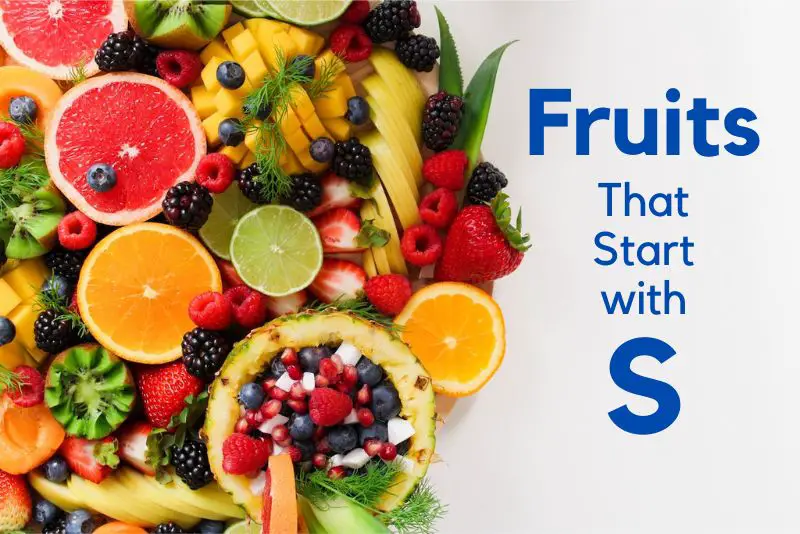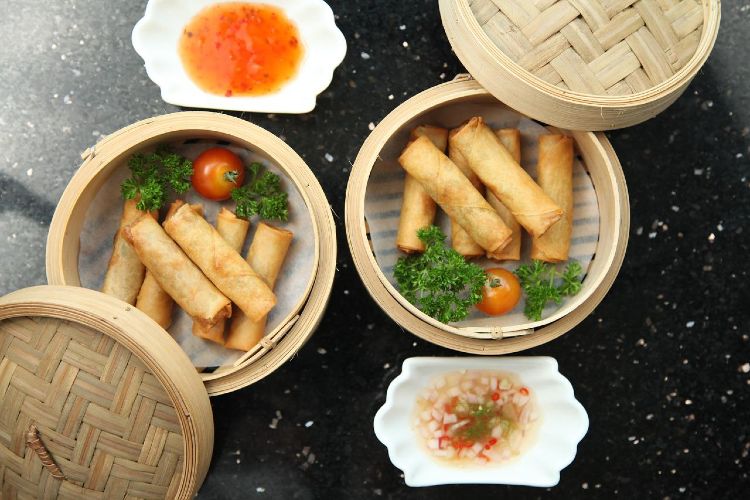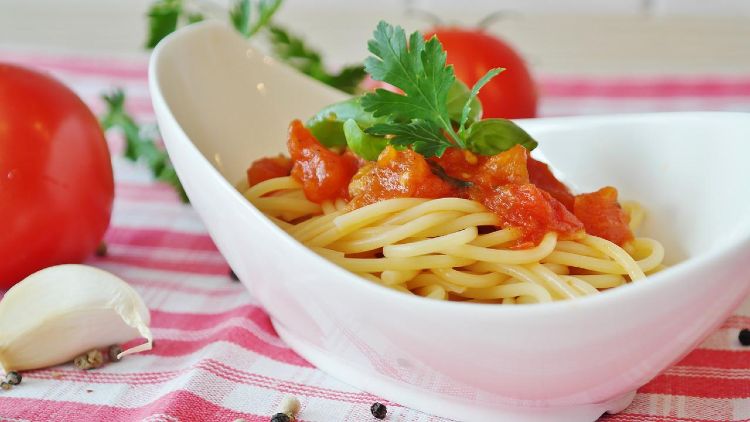Fruits That Start with S (Complete List of 60+ Fruit Names)
Welcome to the world of fruits that start with S!
From succulent berries to exotic tropical delights, this group of fruits offers a diverse and delightful array of flavors, colors, and textures. Each fruit has its own unique charm, whether it’s the sweet juiciness of strawberries, the tangy punch of sour cherries, or the tropical allure of star fruit.
Join us as we explore the wonders of fruits beginning with S., uncovering their fascinating origins, health benefits, and culinary possibilities. Whether you’re a seasoned fruit enthusiast or just starting to explore the world of fruits, you’re in for a delicious adventure as we discover the wonders of “S” fruits!
List of Fruits Starting with S
Safou
Safou, also known as the African pear, is a delicious fruit that grows in Central and West Africa. It has a smooth green skin and a creamy, buttery flesh that is rich in healthy fats. The fruit is often eaten raw or used in various dishes like soups, stews, and sauces. Safou is a good source of vitamins and minerals, providing essential nutrients for a healthy diet. Its unique flavor and texture make it a popular fruit in many African countries.
Saguaro Fruit
Saguaro fruit is the edible fruit of the saguaro cactus, which is native to the Sonoran Desert in North America. These fruits are large, round, and have a bright red color when ripe. The flesh of the fruit is juicy and sweet, with a flavor similar to watermelon. Saguaro fruit has been traditionally used by Native American tribes for food and medicine. It is also an important source of food for desert wildlife, including birds and bats.
Saigon Mango
Saigon mango, also known as the Cambodian mango, is a variety of mango that is highly regarded for its sweet and aromatic flavor. It is named after Saigon (now Ho Chi Minh City), a city in Vietnam where it is believed to have originated. The mango has a golden-yellow skin and juicy, fiberless flesh that is rich in vitamins and antioxidants. Saigon mangoes are often eaten fresh or used in desserts, smoothies, and salads. They are a popular fruit in Southeast Asia and have gained popularity in other parts of the world as well.
Salak
Salak, also known as snake fruit, is a tropical fruit that is native to Indonesia. It gets its name from the reddish-brown scaly skin that resembles snake scales. The fruit has a sweet and tangy taste, with a texture similar to an apple. Salak is often consumed fresh, but it is also used in various dishes, jams, and desserts. The fruit is rich in fiber and contains essential vitamins and minerals, making it a nutritious snack option.
Salal Berries
Salal berries are small, dark purple berries that grow on shrubs in the Pacific Northwest region of North America. These berries have a unique tart and slightly sweet flavor that is often compared to blueberries. They are commonly used in making jams, jellies, pies, and baked goods. Salal berries are rich in antioxidants and vitamin C, offering several health benefits. In addition to being a popular wild food, they are also valued for their ornamental use in floral arrangements.
Salmonberries
Salmonberries are vibrant orange berries that grow in the coastal regions of North America. They are named after their salmon-colored flesh and are known for their sweet and tangy flavor. These berries are often enjoyed fresh, but they can also be used in jams, sauces, and desserts. Salmonberries are a good source of vitamins and minerals, and they are particularly high in vitamin C. They are a favorite treat for bears, birds, and other wildlife in their natural habitats.
Sand Cherry
Sand cherry is a small fruit-bearing shrub that is native to North America. The fruit is small and round with a deep purple or black color when ripe. Sand cherries have a sweet and tart flavor, and they are often used in jams, jellies, and pies. The shrub is also valued for its ornamental qualities, with beautiful pink or white flowers in spring and attractive foliage throughout the year. Sand cherries are a popular choice for landscaping and are enjoyed by both humans and wildlife.
Santol
Santol is a tropical fruit that is native to Southeast Asia, particularly the Philippines. The fruit is round and has a thick, fibrous skin that is usually yellow or brown. Inside, the flesh is white and juicy, with a sweet and sour flavor. Santol can be eaten raw or used in various culinary preparations, including jams, candies, and beverages. The fruit is a good source of dietary fiber and contains vitamins and minerals beneficial for overall health.
Sapo de Piel
Sapo de Piel, also known as the custard apple, is a fruit that is native to the Amazon rainforest in South America. It has a green, scaly skin and soft, creamy flesh that is sweet and fragrant. The fruit is often eaten fresh or used in desserts, smoothies, and ice creams. Sapo de Piel is rich in antioxidants and vitamins, making it a nutritious and delicious treat. It is highly prized in the Amazon region and is gaining popularity in other parts of the world.
Sapodilla
Sapodilla is a tropical fruit that is native to Mexico and Central America. It has a rough brown skin and sweet, grainy flesh that is reminiscent of brown sugar. The fruit is often eaten fresh or used in desserts and milkshakes. Sapodilla is a good source of dietary fiber and contains vitamins and minerals such as vitamin C and potassium. It is a popular fruit in its native regions and is appreciated for its unique flavor and texture.
Sapucaia
Sapucaia is a fruit that grows in the Amazon rainforest and is native to Brazil. It comes from a large tree and has a hard, woody shell with edible seeds inside. The seeds are rich in oils and have a nutty flavor. Sapucaia nuts are often roasted and eaten as a snack or used in cooking, adding a crunchy texture and unique taste to various dishes.
Sarvisberry
Sarvisberry, also known as serviceberry, is a small fruit that grows on shrubs or trees in North America. The berries are round and range in color from red to purple when ripe. They have a sweet and slightly tart flavor, similar to blueberries. Sarvisberries are used in making jams, jellies, and pies. They are also enjoyed fresh and are a favorite food source for birds and other wildlife.
Saskatoon Berry
Saskatoon berry is a fruit native to North America, particularly the Canadian prairies. The berries resemble small blueberries and have a sweet and nutty flavor. They are used in a variety of culinary applications, including pies, tarts, and sauces. Saskatoon berries are also rich in antioxidants and are a good source of fiber and essential nutrients. They are a cherished ingredient in traditional Indigenous cuisine.
Satsuma
Satsuma is a type of mandarin orange that originated in Japan. It is known for its bright orange color and easy-to-peel skin. Satsumas are sweet and juicy, with a refreshing flavor. They are often eaten fresh, and their segments can be added to salads and desserts. Satsuma oranges are rich in vitamin C and are a popular winter fruit enjoyed by many.
Scarlet Fruit
Scarlet fruit, also known as pitanga or Surinam cherry, is a tropical fruit native to South America. It has a bright red color and a tart-sweet flavor. The fruit is small and round, similar to a cherry or a cranberry. Scarlet fruit is often used in making jams, jellies, and beverages. It is rich in antioxidants and vitamin C, making it a healthy addition to one’s diet.
Screwpine
Screwpine, also known as pandan, is a tropical fruit that grows in Southeast Asia. It is characterized by its long, narrow leaves and unique aroma. The fruit itself is small and green, but it is the leaves that are primarily used in cooking and flavoring dishes. The leaves are often used to add a fragrant and sweet taste to rice, desserts, and beverages. Screwpine leaves are highly valued in Southeast Asian cuisine and have a distinct and delightful aroma.
Scuppernong Grape
Scuppernong grape is a type of muscadine grape that is native to the southeastern United States. The grapes are large and have a thick skin, ranging in color from bronze to purple when ripe. They have a sweet and juicy flavor, with a hint of musky undertones. Scuppernong grapes are often used to make wines, jellies, and preserves. They are also enjoyed fresh and are a popular ingredient in southern cuisine.
Sea Buckthorn
Sea buckthorn is a small orange berry that grows on shrubs in coastal regions. It is known for its high nutritional value and health benefits. The berries are sour and tangy, but they are rich in vitamin C and antioxidants. Sea buckthorn berries are used in making juices, jams, and sauces. They are also known for their medicinal properties and are used in traditional herbal remedies.
Seagrape
Seagrape is a fruit that grows on trees along coastal areas, particularly in the Caribbean and Florida. The fruit is round and has a reddish-purple color when ripe. Seagrapes have a sweet and tart flavor, resembling a combination of grapes and plums. They are often eaten fresh and are also used in making jams, jellies, and wines. Seagrapes are enjoyed by beachgoers and are an important part of coastal ecosystems.
Seneca Grape
Seneca grape is a variety of grape that is native to the eastern United States. It is known for its deep blue-purple color and its rich, fruity flavor. Seneca grapes are often used in making wines, juices, and jams. They are also enjoyed fresh and are a popular snack. The grapes are a good source of vitamins and antioxidants, making them a healthy choice for grape lovers.
Seriguela
Seriguela is a tropical fruit that is native to Brazil. It has a unique shape, resembling a small bell or an elongated plum. The fruit has a sweet and tangy flavor, with hints of tropical notes. Seriguela is often eaten fresh, and its pulp is also used in making juices, jams, and ice creams. The fruit is a good source of vitamins and minerals, and it is highly regarded for its refreshing taste.
Serviceberry
Serviceberry, also known as Juneberry or Amelanchier, is a small fruit that grows on shrubs or trees in North America. The berries are round and range in color from red to purple to dark blue when ripe. They have a sweet and slightly tart flavor, reminiscent of blueberries. Serviceberries are used in various culinary applications, including pies, jams, and desserts. They are also enjoyed fresh and are a favorite food source for birds and other wildlife.
Seville Orange
Seville orange is a citrus fruit that is highly regarded for its intense bitter flavor. It is named after Seville, Spain, where it has been cultivated for centuries. The fruit has a bright orange color and a thick, rough skin. Seville oranges are mainly used for making marmalade due to their high pectin content. They are also used in cooking and as a flavoring agent in certain beverages. The distinctive taste of Seville oranges adds a unique and zesty element to culinary creations.
Shadberry
Shadberry, also known as juneberry or saskatoon berry, is a small fruit that grows on shrubs or trees in North America. The berries are round and have a deep purple or dark blue color when ripe. They have a sweet and slightly tart flavor, similar to a combination of blueberries and cherries. Shadberries are used in making pies, jams, and desserts. They are also enjoyed fresh and are a favorite food source for birds and other wildlife.
Shaddock
Shaddock, also known as pomelo, is a large citrus fruit that is native to Southeast Asia. It is the largest citrus fruit and has a thick, green or yellow rind. The flesh of the shaddock is pale yellow or pink and has a sweet and tangy flavor. Shaddocks are often eaten fresh or used in salads and desserts. They are rich in vitamin C and are a popular fruit during the winter season.
Sharon Fruit
Sharon fruit, also known as persimmon, is a fruit that originated in East Asia but is now cultivated in various parts of the world. It has a unique taste and texture, with a sweet and honey-like flavor. Sharon fruit is usually eaten when fully ripe and soft. It can be enjoyed fresh or used in desserts, jams, and baked goods. The fruit is a good source of fiber and contains several vitamins and minerals.
Shonan Gold
Shonan Gold is a variety of citrus fruit that is cultivated in Japan. It is a hybrid of a mandarin orange and a kiyomi, resulting in a fruit with a bright orange color and a sweet and tangy flavor. Shonan Gold has a juicy and seedless flesh, making it easy to eat. The fruit is often enjoyed fresh and is a popular choice during the winter season. It is known for its refreshing taste and nutritional benefits.
Sloe Berries
Sloe berries are small dark purple berries that grow on the blackthorn shrub, primarily in Europe and western Asia. They have a tart and astringent taste, making them unsuitable for eating raw. However, sloe berries are commonly used in the production of sloe gin and other liqueurs. They are also used in jams, jellies, and baked goods. Sloe berries have a long history of culinary and medicinal use and are often associated with traditional folklore.
Snake Fruit
Snake fruit, also known as salak, is a tropical fruit that is native to Indonesia. It gets its name from the reddish-brown scaly skin that resembles snake scales. The fruit has a sweet and tangy taste, with a texture similar to an apple. Snake fruit is often consumed fresh, but it is also used in various dishes, jams, and desserts. The fruit is rich in fiber and contains essential vitamins and minerals, making it a nutritious snack option.
Soncoya
Soncoya is a tropical fruit that is native to Central and South America. It has a large round shape and a greenish-yellow or brownish skin. The flesh of the fruit is creamy and sweet, with a custard-like texture. Soncoya is often eaten fresh, scooping out the flesh with a spoon. The fruit is rich in vitamins and minerals and is highly prized for its delicious taste. It is also used in making ice creams, smoothies, and other desserts.
Sour Cherries
Sour cherries, also known as tart cherries, are a type of cherry with a tangy flavor. They have a vibrant red color and are smaller than sweet cherries. Sour cherries are commonly used in baking and making jams and preserves due to their tartness. They are also popular for their use in pies and other desserts. These cherries are rich in antioxidants and have a distinctive taste that adds a delightful tang to various culinary creations.
Sour Plums
Sour plums, also called tart plums, are a variety of plums that have a sour and tangy taste. They have a firm texture and range in color from yellow to red or purple. Sour plums are often used in making jams, jellies, and sauces. They can also be pickled or dried for longer shelf life. Despite their tartness, sour plums are enjoyed for their unique flavor and are a popular ingredient in certain cuisines.
Soursop
Soursop is a tropical fruit that is native to the Americas. It has a prickly green skin and a soft, creamy white flesh. Soursop has a sweet and tangy flavor, similar to a combination of pineapple and strawberry with a hint of citrus. The fruit is commonly eaten fresh, but it is also used in making juices, smoothies, and desserts. Soursop is known for its potential health benefits and is rich in antioxidants and vitamins.
Southern Crabapple
Southern crabapple is a small fruit-bearing tree that is native to North America. The fruit is small and typically bright red or yellow, resembling a miniature apple. Southern crabapples have a tart and slightly acidic flavor. They are often used in making jellies, preserves, and cider. The tree is valued for its ornamental qualities, with beautiful blossoms in spring and colorful fruit in the fall. Southern crabapples provide a food source for wildlife and are appreciated for their hardiness and resilience.
Spanish Lime
Spanish lime, also known as mamoncillo or genip, is a tropical fruit native to the Caribbean and Central America. It has a green, leathery skin and a small, round shape. Spanish limes have a sweet and tangy flavor, similar to a combination of lime and lychee. The fruit is typically enjoyed by sucking the pulp from the seed. Spanish limes are a refreshing snack and are also used in making beverages, desserts, and sauces.
Spiked Melon
Spiked melon, also known as horned melon or kiwano, is a unique fruit that is native to Africa. It has a spiky orange or yellow skin and a vibrant green jelly-like flesh filled with edible seeds. Spiked melon has a refreshing and slightly tangy taste, similar to a mix of cucumber, banana, and passionfruit. It is often used as a garnish, in salads, or blended into juices and smoothies. The distinctive appearance and taste of spiked melon make it a visually striking and flavorful fruit.
Splendor Apple
Splendor apple is a variety of apple that is known for its attractive appearance and crisp texture. It has a vibrant red skin with yellow undertones. Splendor apples have a sweet and slightly tart flavor, making them enjoyable for fresh eating. They are also suitable for use in baking, cooking, and making applesauce. Splendor apples are known for their juiciness and aromatic qualities, contributing to their popularity among apple enthusiasts.
Star Apple
Star apple, also known as cainito or chrysophyllum, is a tropical fruit that is native to the Caribbean. It has a purple or green skin and a star-shaped pattern on the inside, giving it its name. The flesh of the fruit is sweet and creamy, with a texture similar to a custard. Star apples are usually eaten fresh, scooping out the flesh with a spoon. They are appreciated for their unique appearance and delightful taste.
Star Fruit
Star fruit, also known as carambola, is a tropical fruit that is native to Southeast Asia. It gets its name from its distinctive star-shaped cross-section when sliced. Star fruit has a yellow or green color and a sweet and tangy flavor. It is often enjoyed fresh or used as a decorative element in fruit salads and beverages. Star fruit is rich in vitamin C and is a good source of dietary fiber. Its star-like appearance and tropical taste make it a popular and eye-catching fruit.
Stinking Bishop Pear
Stinking Bishop pear is a unique variety of pear that is known for its strong aroma. It has a greenish-yellow skin and a soft, juicy flesh. Stinking Bishop pears have a rich, sweet flavor with hints of spice and earthiness. They are often used in making traditional British cheeses due to their unique scent. The pears are also enjoyed fresh and are appreciated for their distinct and flavorful characteristics.
Strawberries
Strawberries are small, juicy, and red fruits that are loved for their sweet and slightly tart taste. They are widely cultivated and enjoyed worldwide. Strawberries can be eaten fresh, used in desserts like cakes and pies, or made into jams and preserves. They are rich in vitamin C, antioxidants, and dietary fiber, making them a healthy and delightful treat.
Strawberry Guava
Strawberry guava, also known as cattley guava, is a tropical fruit that has a distinctive strawberry-like flavor. It has a small round shape and a pink or yellow skin. The fruit is often eaten fresh, and it can also be used in making juices, jams, and desserts. Strawberry guava is a good source of vitamins A and C and provides a tropical twist to the traditional strawberry taste.
Strawberry Pear
Strawberry pear, also called pitaya or dragon fruit, is a vibrant and exotic-looking fruit with a mild, sweet taste. It has a pink or white flesh dotted with tiny black seeds. Strawberry pears are typically eaten fresh, either sliced or scooped out with a spoon. They are a good source of fiber, antioxidants, and vitamin C, making them a nutritious and visually appealing addition to fruit salads and smoothies.
Sudachi
Sudachi is a small citrus fruit native to Japan. It is green in color and has a refreshing and tangy taste, similar to a combination of lime and yuzu. Sudachi is often used as a condiment or flavoring agent in various dishes, including salads, sauces, and soups. The juice and zest of Sudachi are highly prized in Japanese cuisine for their unique and citrusy flavor.
Sugar Apple
Sugar apple, also known as custard apple or sweetsop, is a tropical fruit with a sweet and creamy taste. It has a knobby green skin and soft, white, and custard-like flesh. The fruit is typically eaten fresh, scooping out the flesh with a spoon to enjoy the sweet and juicy pulp. Sugar apples are rich in vitamins and minerals, particularly vitamin C and potassium, making them a delicious and nutritious tropical treat.
Sugar Baby Watermelon
Sugar Baby watermelon is a small, round watermelon variety known for its sweet and juicy flesh. It has a dark green rind and red or pink interior with black seeds. Sugar Baby watermelons are a popular summer fruit and are often enjoyed chilled as a refreshing snack. They are also used in fruit salads, smoothies, and desserts, making them a delightful addition to summertime menus.
Sugarberry
Sugarberry, also called hackberry or Celtis, is a small purple or black fruit that grows on trees in North America. The fruit has a sweet and slightly nutty flavor, and it is often enjoyed fresh or used in making jams and desserts. Sugarberries are rich in antioxidants, fiber, and vitamins, making them a nutritious and tasty addition to the diet.
Sumo Citrus
Sumo citrus, also known as Dekopon or Hallabong, is a large and seedless mandarin orange variety that originated in Japan. It has a bumpy and thick rind, which makes it easy to peel. Sumo citrus has a sweet and juicy flesh with a hint of tartness. It is highly prized for its rich flavor and is often considered one of the best-tasting citrus fruits. Sumo citrus is enjoyed fresh and is a popular choice during the winter season.
Sunset Apple
Sunset apple is a variety of apple known for its vibrant red and orange skin. It has a crisp texture and a sweet and tangy flavor. Sunset apples are versatile and can be enjoyed fresh, used in cooking and baking, or made into applesauce and cider. They are a good source of fiber and antioxidants, making them a healthy snack option. The attractive appearance and delicious taste of Sunset apples make them a favorite among apple enthusiasts.
Surinam Cherry
Surinam cherry, also known as pitanga, is a small red fruit that grows on a tropical tree. It has a sweet and tart flavor, reminiscent of a mix between cherries and cranberries. Surinam cherries are often eaten fresh, used in jams and jellies, or made into beverages. They are rich in vitamin C and antioxidants, making them a healthy and flavorful addition to your diet.
Sweet Granadilla
Sweet granadilla, also called passionfruit, is a tropical fruit with a unique flavor. It has a round or oval shape and a thick, wrinkled skin. Inside, the fruit is filled with orange pulp and black seeds. Sweet granadilla has a sweet and tangy taste, with a floral and tropical aroma. It is commonly used in desserts, juices, and cocktails, adding a burst of tropical flavor.
Sweet Lemon
Sweet lemon, also known as sweet lime or mosambi, is a citrus fruit that is smaller and sweeter than traditional lemons. It has a thin, yellow-green skin and juicy, pale yellow flesh. Sweet lemons have a mild and sweet flavor, with less acidity compared to regular lemons. They are often used in making beverages, marinades, and desserts, or enjoyed fresh as a refreshing snack.
Sweet Lime
Sweet lime, also known as sweet lemon or mitha nimbu, is a citrus fruit that resembles a small, round lemon. It has a pale yellow to greenish-yellow skin and sweet, juicy flesh. Sweet limes have a mild and sweet flavor with low acidity, making them enjoyable to eat fresh or use in salads, beverages, and desserts. They are a good source of vitamin C and provide a refreshing burst of citrus flavor.
Sweet Orange
Sweet orange is a popular citrus fruit known for its sweet and juicy taste. It has a bright orange rind and segments filled with flavorful pulp. Sweet oranges are commonly eaten fresh, juiced, or used in a variety of culinary applications. They are rich in vitamin C and other essential nutrients, making them a healthy and refreshing choice. From snacking to baking, sweet oranges are a versatile and delicious fruit.
Sweet Pepper
Sweet pepper, also known as bell pepper or capsicum, is a vegetable that is often treated as a fruit in culinary contexts. It comes in various colors, including green, red, yellow, and orange. Sweet peppers have a crunchy texture and a mild, sweet flavor. They are widely used in cooking, salads, stir-fries, and stuffed pepper dishes. Sweet peppers are packed with vitamins and antioxidants, adding both taste and nutrition to meals.
Sweetbay Magnolia
Sweetbay magnolia is a tree native to the southeastern United States. It produces fragrant white flowers that give way to cone-shaped fruits. The fruits of sweetbay magnolia are reddish-brown and contain bright red seeds. Although not typically consumed by humans, they serve as a valuable food source for wildlife, particularly birds. Sweetbay magnolia is appreciated for its ornamental qualities and its contribution to the natural ecosystem.
Sycamore Fruit
Sycamore fruit, also known as buttonball or seed ball, is the fruit of the sycamore tree. It consists of a spherical cluster of seeds surrounded by a ball-shaped casing. The casing is brown and woody, and it breaks apart to release the seeds when mature. The seeds are small and have a fluffy structure that aids in their dispersal by the wind. Sycamore fruits add visual interest to the tree and can be found hanging from the branches throughout the year.
In conclusion, fruits that start with S bring a delightful and diverse range of flavors, textures, and nutritional benefits to our tables. From the sweetness of strawberries and sweet oranges to the tartness of sour cherries and soursop, these fruits offer something for every palate.
Whether you’re indulging in the tropical allure of star fruit or savoring the juicy burst of a sugar apple, the world of “S” fruits never fails to surprise and delight. So, next time you find yourself perusing the produce aisle or exploring a farmer’s market, don’t forget to seek out these sensational fruits that begin with “S” and let your taste buds revel in their delicious offerings.






